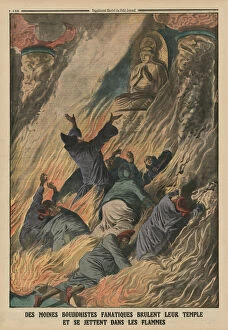Immolation Collection
"Immolation: A Haunting Portrait of Sacrifice and Protest" In the annals of history, there are moments that etch themselves into our collective memory
All Professionally Made to Order for Quick Shipping
"Immolation: A Haunting Portrait of Sacrifice and Protest" In the annals of history, there are moments that etch themselves into our collective memory, forever altering our perception of human resilience and conviction. One such moment occurred on June 11, 1963, at a bustling intersection in Saigon, South Vietnam. Buddhist monk Thich Quang Duc stood resolute amidst a sea of turmoil and injustice, committing an act so profound it would shake the world. Thich Quang Duc's self-immolation was not an isolated incident but rather a poignant protest against the anti-Buddhist measures imposed by President Ngo Dinh Diem. As Malcolm Browne's lens captured this harrowing scene for eternity, it became an indelible symbol of resistance against oppression. Yet immolation is not confined to one culture or time; its roots delve deep into ancient customs and rituals. The practice known as Suttee in Hinduism emerges from the depths of history – a funeral custom where widows willingly embraced their husbands' pyres to join them in death. Engravings depicting these solemn preparations reveal both reverence and controversy surrounding this tradition. From Greek mythology to historical accounts across continents, it has woven itself into narratives that explore sacrifice beyond comprehension. In frescoes like "The Sacrifice of Iphigenia, " we witness the heart-wrenching choice made by Agamemnon – sacrificing his own daughter for victory in war. As we traverse through time, witnessing these acts unfold before us through engravings like "Avadne Immolates Herself" or "Immolation Of A Hindu Widow Upon Her Husband's Funeral Pile, " we grapple with complex emotions stirred by devotion mingled with tragedy. However varied these instances may be – whether rooted in religious fervor or political dissent – they all share a common thread: individuals driven to extreme measures for causes they hold dear.









